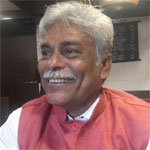Ashok Hande’s entertainment show Marathi Baana (Marathi pride) is a one-of-a-kind cultural carnival which brings to life the rich treasures of Marathi culture. It has been running to packed houses for over a decade and refuses to stop attracting the crowd. The show, as the name suggests, sings the paeans of popular Marathi literature and cultural icons.
Hande felt that there would be an interesting programme by weaving together the history, traditions, music and dance and present it with the latest and modern technical support, to bring back to Maharashtrians, their Marathi pride. Interestingly the Marathi Baana is written, directed, narrated, conceived and produced by Hande himself.
Paying homage
Marathi Baana pays homage to singers and composers like Sudhir Phadke, humourists like P.L. Deshpande, lyricists like Suresh Bhat, sportsmen like Ajit Wadekar, politicians like Bal Thackeray, film personalities like V. Shantaram, Shreeram Lagoo, etc. It is a brainchild of Hande and comprises 125 artistes who perform ritualistic dances right from Gondhal, jogwa, and other traditional art forms like koli dance and lawani. It is full scale celebration of Maharashtrian culture for nearly two and a half hours.
The maiden show of Marathi Baana was presented at Gagangiri Maharaj Ashram, Manori, Malad (W), in October 2005. The show was received with unprecedented applause and prompted Hande to make it a commercial venture. And the rest is history. The first commercial show was presented on 1 November 2006 at Dinanath Mangeshkar Auditorium, Vile Parle (E), as Diwali Pahat (morning celebrations of Diwali festival). The Dinanath Hall show was an instant hit and displayed ‘house full’ board. The show is presented by Ashok Hande’s ‘Chaurang’. Hande’s Chaurang has presented many other programmes like Mangalgani-Dangalgani, Amrut Lata, Madhubala, etc. Hande established Chaurang (a Sanskrit word for three colours mixed to form a fourth), in 1987.
Marathi Baana starts with Uthi uthi gopala, a bhupali song that is sung in the early hours of the morning. Several songs like Vasudevaala and abhangas explained the rural life, followed by the farmer’s dance Shetkari Dada Ale. Then comes a thakar dance based on the song Amhithakarthakar that explains the tribal life in Maharashtra. In the dance item Lingobacha dongar aabhalala gela, artists made a human pyramid with flawless skill and speed, which brought audiences to their feet. Other festivals like Ganapati, Namankhele and Diwali are presented through eye-catching dances. A large number of ladies dances and games were showcased through Mangalagaur pooja and ladies games like zimma, fugdi and interesting songs like nach ghuma, lakh lakhchanderi were performed with lighted lamps. As Shivaji Maharaj is the idol and inspiration of Maharasthra, the show concludes with the vigorous notes of Prabho Shivaji Raja.
Hande ensures that there is no vulgarity in the show. Though his shows have lavani performances, they do not have an iota of obscenity. This is precisely why he gets women audiences in record number. There are families who have seen his shows more than a dozen times. Before mounting any new show, Hande’s team takes the pain to do thorough research of the topic, and only then is it taken further. No wonder the show has already crossed the famed 1000-shows mark.


 [/column]
[/column]